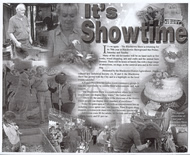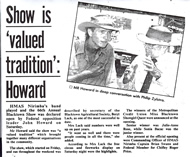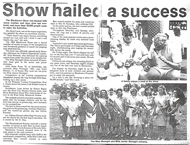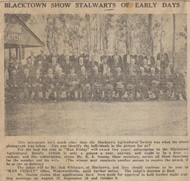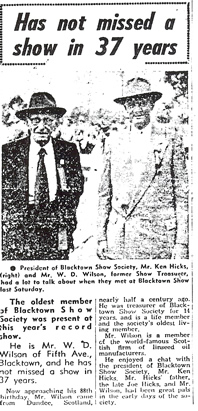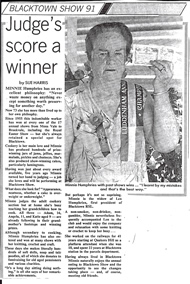The Blacktown Show History
WE NEED YOUR HELP If you have any old photos, stories or memorabillia associated with the Blacktown Show – we would love to hear from. Please contact us today.
—————————————————————————–
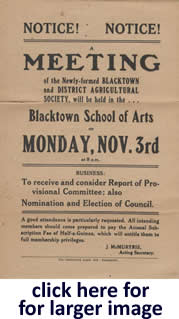 The Blacktown Show Society was formed in 1918 at the instigation of James Simpson who had been an active member of Grenfell Show.
An exhibition organised by the Blacktown Agricultural Bureau was held at the saleyards by the railway line on the 5th and 6th of April 1918.
The first show presented by the Blacktown & District Agricultural Society was held at the Blacktown School of Arts on Friday and Saturday, 22 and 23 April 1920. Poultry and pigeons were exhibited at the rear of the hall, with sideshows, wood chopping etc in an adjoining paddock.
The Blacktown Show Society was formed in 1918 at the instigation of James Simpson who had been an active member of Grenfell Show.
An exhibition organised by the Blacktown Agricultural Bureau was held at the saleyards by the railway line on the 5th and 6th of April 1918.
The first show presented by the Blacktown & District Agricultural Society was held at the Blacktown School of Arts on Friday and Saturday, 22 and 23 April 1920. Poultry and pigeons were exhibited at the rear of the hall, with sideshows, wood chopping etc in an adjoining paddock.
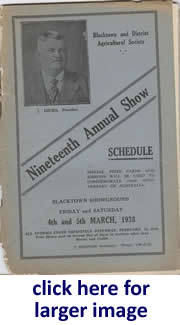 February 18 and 19, 1921 saw the second show held “in a paddock a convenient distance from the railway station”. The 1921 show was held in the Inglis saleyards adjoining the Richmond railway line at Blacktown. The site of the present showground was acquired in 1922 and a trotting track formed.
The 3rd show was the first held in the Showground, on March 3 and 4 1922. Over 5000 people attended and it was halied “A Big Success”.
February 18 and 19, 1921 saw the second show held “in a paddock a convenient distance from the railway station”. The 1921 show was held in the Inglis saleyards adjoining the Richmond railway line at Blacktown. The site of the present showground was acquired in 1922 and a trotting track formed.
The 3rd show was the first held in the Showground, on March 3 and 4 1922. Over 5000 people attended and it was halied “A Big Success”.
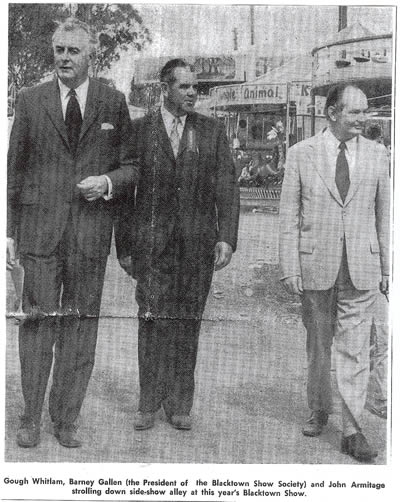 Except for a brief period during World War 2 when the Army took over the Showground to use as a maintenance depot, the Show has been held on a regular basis.
The first president was J.H.S.Angus, who became deputy president of the RAS, with J.McMurtie as secretary.
Blacktown Presidents are noted for their long terms of office.
Jos Hicks 1924-1939.
Ken Hicks 1939 -1968
C.K. Gallen 1969 -2003
Except for a brief period during World War 2 when the Army took over the Showground to use as a maintenance depot, the Show has been held on a regular basis.
The first president was J.H.S.Angus, who became deputy president of the RAS, with J.McMurtie as secretary.
Blacktown Presidents are noted for their long terms of office.
Jos Hicks 1924-1939.
Ken Hicks 1939 -1968
C.K. Gallen 1969 -2003
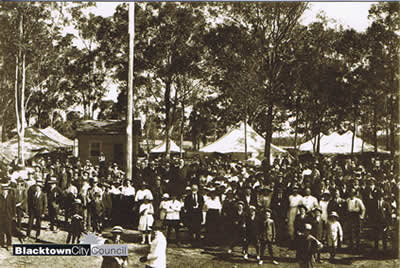

 The New South Wales Government considered the Blacktown Agricultural Society’s showground important enough to send ‘the big fella’, Treasurer J.T.’Jack’ Lang to open it in 1922.
The New South Wales Government considered the Blacktown Agricultural Society’s showground important enough to send ‘the big fella’, Treasurer J.T.’Jack’ Lang to open it in 1922.
HISTORY THROUGH THE NEWSPAPERS
click on each of the clippings to read each article
Gordon Davis. Jack Adams, James Simpson 1973
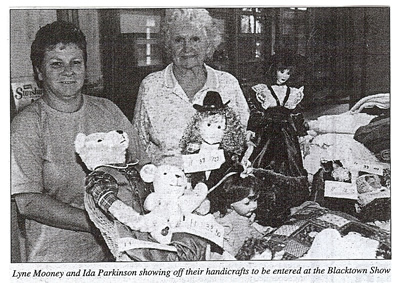
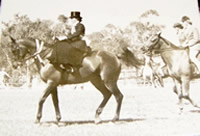
EARLY SHOW RIDER
—————————————————————————–

Ken Hicks took over as President of the Society in 1929. He succumbed his father, who had been President for 20 years. Ken remained President until his death in 1968.

Jim Simpson (1904 – 2002) was an honoury life member of the Blacktown and District Agricultural, Horticultural and Industrial Society. His father, James Simpson Snr was one of the driving forces in the founding of the society and Jim joined and attended meetings from an early age.
He was a member of the Society for 84 years and held many positions within the group. He acted as Steward at many of the Shows and at various times was Treasurer, Senior Vice President and Secretary.

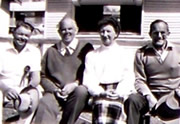
Officials of the Society 1986
Some of the officials of the Society. Mr Pat Hunt, Mr Barney Gallen President, Mrs Beryl Luck Secretary and Mr David Luck Vice PresidentThe History of The Blacktown Show: A Journey Through Time
Introduction
Nestled in the heart of New South Wales, Australia, Blacktown is a bustling suburb known for its rich cultural diversity and vibrant community spirit. One of the most iconic representations of this spirit is the annual Blacktown Show. This event, spanning several decades, has become a cornerstone of the community’s identity. In this comprehensive blog post, we delve into the history of the Blacktown Show, exploring its evolution from humble beginnings to becoming one of the area’s most anticipated events.
The Early Years: The Birth of a Community Tradition
The origins of the Blacktown Show trace back to the early 20th century. It began as a small community fair, designed to bring together the residents of Blacktown and the surrounding areas. Initially, the focus was on agriculture, reflecting the region’s rural roots. Farmers and locals would gather to showcase their produce, livestock, and farming techniques.
A Reflection of Agricultural Heritage
In these early years, the show served as a platform for farmers to exchange ideas and compete in friendly contests. Cattle shows, sheepdog trials, and equestrian events were among the highlights. The community’s engagement with these events was a testament to the agricultural lifestyle that was prevalent in Blacktown at the time.
Growth and Transformation: Adapting to a Changing Society
As Blacktown began to grow and urbanize post-World War II, the Blacktown Show evolved in tandem. The increase in population and the diversification of the suburb saw the show expanding its scope beyond agriculture.
The Introduction of Entertainment and Rides
The 1950s and 60s marked a significant shift in the show’s character. This period saw the introduction of carnival rides, sideshows, and various forms of entertainment. The aim was to cater to a broader audience, including families and children, and to reflect the changing dynamics of the Blacktown community.
Cultural Diversity Takes Center Stage
With the influx of migrants from various parts of the world, Blacktown transformed into a melting pot of cultures. The Blacktown Show began to incorporate multicultural elements, showcasing performances, arts, and cuisine from different ethnic communities. This not only enriched the show’s offerings but also fostered a sense of inclusion and unity within the diverse population.
The Modern Era: A Showcase of Community and Innovation
Entering the 21st century, the Blacktown Show continued to grow, both in scale and in the variety of attractions offered. It became a reflection of modern Blacktown – vibrant, diverse, and forward-looking.
Embracing Technology and Modern Entertainment
With advancements in technology, the show incorporated more sophisticated rides and digital entertainment. The introduction of sound stages, lighting effects, and multimedia presentations added a new dimension to the event.
Environmental Consciousness and Sustainability
In recent years, there has been a conscious effort to make the Blacktown Show more environmentally friendly. Initiatives like waste management, recycling programs, and the use of sustainable materials are examples of this shift. The show began to serve not only as a platform for entertainment but also as a champion for environmental awareness and action.
The Blacktown Show Today: A Culmination of History and Hope
Today, the Blacktown Show stands as a testament to the suburb’s evolution. It is a celebration of history, community, and cultural diversity.
A Calendar Highlight
The show is now firmly etched as a highlight in Blacktown’s annual calendar, attracting thousands of visitors from all over Sydney and beyond. It offers a unique blend of entertainment, education, and cultural exposure.
Community Engagement and Economic Impact
The show significantly impacts the local economy and community engagement. It provides a platform for local businesses, artists, and performers to showcase their talents and products. The event also fosters community spirit, bringing together people from various backgrounds in a shared experience.
The Future of The Blacktown Show
As we look to the future, the Blacktown Show is poised to continue its evolution. There is a growing emphasis on inclusivity, innovation, and sustainability. The organizers are continually exploring ways to make the show more accessible, engaging, and environmentally responsible.
Embracing Change While Honoring Tradition
While the show is set to embrace new trends and technologies, its core ethos remains the same – to celebrate the community’s spirit and heritage. The challenge lies in balancing innovation with tradition, ensuring that the show remains relevant and exciting for future generations.
Conclusion: A Legacy Continues
The Blacktown Show’s journey from a small agricultural fair to a large-scale community event is a story of growth, adaptation, and resilience. It mirrors the evolution of Blacktown itself – from a rural outpost to a vibrant urban suburb. As the show continues to evolve, it stands as a beacon of community spirit, celebrating the past, present, and future of Blacktown. For residents and visitors alike, the Blacktown Show remains a symbol of unity, diversity, and enduring community values.
